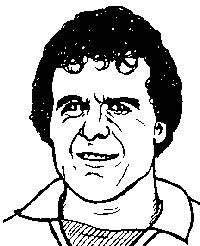
| John Burridge |
|---|
With Harkouk having gone to Q.P.R. and Silkman shortly to join Malcolm Allison at Plymouth, the attack was augmented by the £180,000 signing of Mike Elwiss from Preston, who kept Ian Walsh out of the side for the first dozen games. Elwiss was the latest and most promising in a growing list of partners up front for Swindlehurst, succeeding Mick Hill, Dave Kemp, Steve Perrin and Jeff Bourne. He had once been on the verge of signing for Liverpool four years earlier while at Doncaster, but the deal fell through when the club bumped up his price at the last minute. Although not a very prolific goalscorer to start with, Elwiss was a skilful ball player of the type Venables has always admired, and his influence resulted in Palace's neat passing moves being extended into the penalty area, with speculative long range shots becoming a rarity. Although most people expected Palace to be among the front runners once again, even the fans were surprised at how well the season began, with them quickly going to the top of the table and remaining unbeaten for 11 games. Evidence that this was to be Palace's lucky season came in the 1-1 home draw with West Ham, with Billy Gilbert's fluked goal from his own half reminiscent of John Sewell's famous punt against Leeds years earlier.
In the League Cup it took First Division Aston Villa two replays to get past Palace, with the final 3-0 scoreline at Coventry's neutral ground being easily the heaviest defeat of the season, and the only time all year that John Burridge let in more than two goals. Indeed, it is unlikely that Palace's defensive record for the season - 24 goals conceded in 42 league games - will ever be equalled, and has certainly never been approached since. To attribute Palace's success simply to the defence, though, would be a mistake, because the essence of their game was controlled possession in every area of the field - Venables' European dream realised in the English Second Division. In midfield the cocksure Jerry Murphy was already a master of first time control and accurate passing, and Peter Nicholas, although less adventurous with the ball, invariably found himself in the right position to either attack or defend. The genuine element of flair came from Vince Hilaire, outrageously skilful although inconsistent, and always looking for the chance to get the ball at his feet and go past the full back. The final component which made the midfield complete was the signing of Steve Kember from Leicester, which meant Chatterton finally moving on to Millwall. Kember's return to Selhurst Park after seven years away turned&n
| Paul Hinshelwood |
|---|
Having started the season so well, a slight dip in results after Christmas, with seven draws from nine games, served as a warning against complacency, and a promising F.A.Cup run was thwarted in the fifth round with a surprising home defeat at the hands of Wolves. Come the spring, however, the young players blossomed again, with Ian Walsh proving an admirable replacement for Elwiss up front, and the defence becoming even meaner, conceding only five goals in the final 17 games. Remarkably, with only three games to go, Palace were occupying their lowest position of the whole season - fourth behind Stoke, Brighton and Sunderland - and with no apparently easy fixtures remaining. Venables had been saying all season that with no outstanding team in the Division nothing would be decided until the final kick, and so it proved.
The 2-0 home victory over a very ordinary Notts County was comprehensive enough, but it was the next game, at Orient's cramped Brisbane Road ground, that was to prove crucial, for a defeat would in the event have condemned Palace to another frustrating year in Division Two. The latter half of the season had taught the players to fight for possession when they weren't being given space by the opposition and this quality, typified by Steve Kember more than anyone, enabled them to scrape through a tense game and hang on to the narrow lead provided by Swindlehurst's goal.
That victory, under such pressure against a good side, boosted their confidence and that of the fans, so that when it came to the last game - a rearranged fixture against Burnley on the Friday night before the Cup Final - an amazing crowd of 51,482 turned out to witness another piece of Selhurst Park history, a crowd figure that will never be equalled. Promotion was still not certain, with at least a point needed to climb above Sunderland in third place, but in the event the passionate atmosphere, enhanced as always under t
| Ian Walsh |
|---|